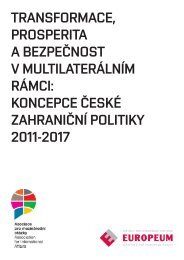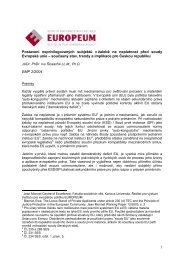eu constitutionalisation - EUROPEUM Institute for European Policy
eu constitutionalisation - EUROPEUM Institute for European Policy
eu constitutionalisation - EUROPEUM Institute for European Policy
You also want an ePaper? Increase the reach of your titles
YUMPU automatically turns print PDFs into web optimized ePapers that Google loves.
Chapter 2: The Convention and IGC Texts of the Constitutiona stable consensus that was able to survive the IGC because a previousconsensus already existed.2) Sensible issues, with high political saliency and redistributive effects (Budget,Institutional architecture, QMV, revision, rein<strong>for</strong>ced cooperation, <strong>for</strong>eignpolicy) proved to be more controversial, giving the pace to asymmetricalrelation of power and bargaining. In these areas the consensus that wasachieved was apparent and the IGC re-opened the discussion.This analysis it will put in evidence that the Convention method, provedto be effective in areas with low political saliency whereas in issues of highpolitical salience, even producing a good base <strong>for</strong> a further agreement, itdid not succeed to reach a stable consensus.The instability of high political saliency issuesThe case of the institutional architectureAn example that comes to the evidence is the question of the institutionalarchitecture which proved to be one of most controversial issues and lessstable of the Convention text. The first victim of the IGC (that lasted nearlyone year) was the proposed creation of a legislative Council³³. The proposalof the Convention was aimed at rationalising the activities of Council inorder to separate the legislative function from the executive one, avoidingthus the fragmentation of the several <strong>for</strong>mations of the Council. A step inthis direction was already made from the Seville <strong>European</strong> Council³⁴ thathad decided to limit the <strong>for</strong>mation of the Council to just nine. The idea wasto have a kind of second chamber that would legislate together with the<strong>European</strong> Parliament, but there was much opposition from an ideologicaland also from a technical point of view. The new figure of the legislativeminister representing the government would then have taken the place ofthe sectoral ministers, achieving a too much influential role.³⁵Such a changewould have also had important repercussion on the domestic structure ofthe governments. The IGC in the end accepted only to divide the task ofthe Council between a legislative phase in which it will deliberate in publicand the executive one, maintaining the actual <strong>for</strong>mation of the Council.33) Art. I-23 CT(CONV), Art. I-24 CT (CONV)34) Presidency Conclusions, Seville <strong>European</strong> Council, 21 and 22 June 2002.35) REICH (2004).Chapter 2: The Convention and IGC Texts of the ConstitutionThe new system of QMV was also a conflicting issue that the Conventiontext addressed without being able to reach stable consensus. The proposedsystem of the 50 per cent of the States and the 60% of the population wasthe results of the <strong>for</strong>cing of Giscard d’Estaing, supported by the coalitionof the bigger states that ignored the opposition of the small and middlesize states. This distribution had the merit of being more transparent butwas disproportionably advantaging the bigger states at the detriment ofmedium size. The IGC moved a step <strong>for</strong>ward by finding a new compromiseincreasing the threshold to respectively 55 per cent and 65 per centand when the Council is not acting on a proposal of the Commission, toa majority of 72 per cent of states and 65 per cent of the population³⁶. Butmore importantly it included a series of safety guarantees in order to limitthe effect of these new rules: the fact that a minimum winning coalitionshould be <strong>for</strong>med by 15 members and that a minority should be constitutedby at least 4 member states. The most evident setback from the IGC wasalso the rescuing of a kind of Ioannina compromise that would have beenapplied till 2014; such a clause will oblige the Council to continue searching<strong>for</strong> an agreement if there is a three-quarters of the members states <strong>for</strong>minga minority against the issues in question. The IGC rolled back on thescope of the QMV in area like taxation and <strong>for</strong> certain budgetary decisionsand also in domain of social security and justice and criminal cooperation.This setback was complemented by the quasi nullification of the “passerelleclauses”³⁷, specifically designed to allow the <strong>European</strong> Council to decid<strong>eu</strong>nanimously to swift one domain from the unanimity to the qualifiedmajority procedure or to pass from the special legislative procedure to theco-decision procedure, only in some areas of part III of the Constitution.The Art. IV-444 clearly stated that every initiative under this article must becommunicated to all the parliaments of the member states (giving thema period of six months to react) and that in case of opposition of just onethe decision would not then be adopted.In terms of institutional arrangements the draft of the Convention wasalmost criticized in relation to the composition of the Commission. Thesolution of a two tire commission with a representative <strong>for</strong> each memberstates but just 13 commissioners plus the Minister of Foreign Affairs witha right to vote and being part of the college, was soon abandoned because36) Art. I-25 CT.37) Art. IV-444 CT, Simplified revision clause.66 67








